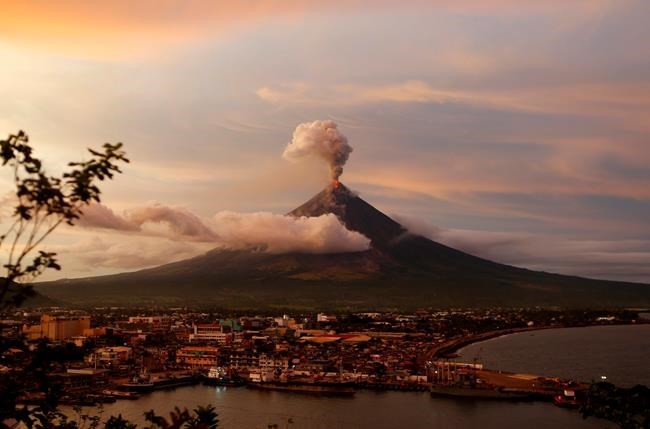
The Mayon volcano continues to erupt as the sun sets behind Legazpi city, Thursday, Jan. 25, 2018 in Albay province, roughly 340 kilometers, (200 miles) southeast of Manila, Philippines. (AP Photo/Bullit Marquez)
Republished January 26, 2018 - 1:33 AM
Original Publication Date January 25, 2018 - 5:31 PM
LEGAZPI, Philippines - A Philippine volcano which has repeatedly disgorged fountains of lava, ash and molten rock and driven more than 78,000 villagers from their homes remains swollen with magma and could erupt destructively, an official said Friday.
In its nearly two weeks of erupting, Mount Mayon in the northeastern province of Albay may have ejected roughly 30 per cent of its magma but its swollen sides indicate more molten material may have risen near the crater ahead of a potentially more powerful blast, said Renato Solidum of the Philippine Institute of Volcanology and Seismology.
"We still have a significant amount within the volcano as it is still inflated," Solidum told reporters in Legazpi city, Albay's capital, where life went on normally within sight of the cloud-shrouded volcano.
"It is possible that it can be transformed into a more explosive phase ... where the actual explosion will be more powerful than what is being shown right now," he said.
Solidum said the possible explosion could be as powerful as Mayon's major eruptions during the last 50 years, including one in 2000 in which it blew ash 17 kilometres (11 miles) into the sky. Some past eruptions have been deadly, including an 1814 blast that buried an entire town in volcanic debris and left 1,200 people dead, but there have been no reports of injuries in its current eruption.
Officials are worried it may continue for months, disrupting the lives and livelihoods of people in Mayon's shadow. They also fear that if a storm blows near, heavy rain could wash down thick ash, lava and rocks in rampaging volcanic flows called lahar and devastate villages in its foothills.
A villager, Alicia Marzen, complained of her family's ordeal in one of the dozens of schools turned into emergency shelters, where children lie on cold floors and some have become sick. "In our room some evacuees have a fever which others acquired because we lay down on the floor," Marzen said. "Now my grandson has a cough and cold."
Elsewhere, residents accustomed to Mayon's fury have gone about their lives as the volcano repeatedly spewed red-hot lava and ash columns into the blue sky over the past weeks, including in Legazpi, where shopping malls, restaurants and coffee shops continue to buzz.
One couple reportedly went on with their wedding despite the emergency and had pictures taken with the erupting volcano as a backdrop.
Farmers, however, have had to abandon their rice, vegetable and poultry farms within an eight-kilometre (five-mile) danger zone around Mayon. The initial damage to agriculture alone during the past two weeks has exceeded $2 million, Albay provincial agricultural officer Cheryll Ribeta said Thursday.
Mayon has erupted about 50 times in the last 500 years. In 2013, an ash eruption killed five climbers who had ventured near the summit despite warnings.
The Philippines has about 22 active volcanoes. The explosion of Mount Pinatubo in 1991 was one of the biggest volcanic eruptions of the 20th century, killing hundreds.
___
Associated Press writer Jim Gomez in Manila, Philippines, contributed to this report.
News from © The Associated Press, 2018